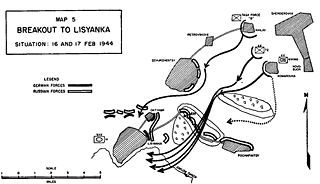The 2nd Army was a field army of the German Army during World War II.

The 9th Army was a World War II field army. It was activated on 15 May 1940 with General Johannes Blaskowitz in command.
The 1st Ski Division was a mountain infantry unit of the German Waffen-SS/Army trained to use skis for movement during winter. It was created on the Eastern Front in the autumn of 1943 in preparation for upcoming winter operations. It was enlarged into a full division in the summer of 1944. The division fought exclusively on the Eastern Front as part of Army Group Centre, including an approach to the Vistula river and during the retreat into Slovakia, southern Poland and the Czech lands, where it surrendered to the Red Army in May 1945.

The German 20th Infantry Division was an infantry division of Nazi Germany.
Army Group Vistula was an Army Group of the Wehrmacht, formed on 24 January 1945. It lasted for 105 days, having been put together from elements of Army Group A, Army Group Centre, and a variety of new or ad hoc formations. It was formed to protect Berlin from the Soviet armies advancing from the Vistula River.
The XXVIII Army Corps was a corps which served in Nazi Germany's Wehrmacht during World War II. The corps was created on May 20, 1940 in Wehrkreis III. During the war, the corps was subordinated to the German 6th, 16th, 18th, and 3rd Panzer Armies. In 1945, the corps was briefly named Armeeabteilung Samland. The corps fought in Samland until annihilated in late April 1945.

The 19th Army was a World War II field army of the German Army. Active from 1943 to 1945 on the Western Front, it was tasked with defending southern France and before being pushed back to the French–German border during Operation Dragoon and then into southern Germany.
The 19th Panzer Division was an armoured division in the German Army, the Wehrmacht, during World War II. It was created from the 19th Infantry Division.

The 72nd Infantry Division was formed on 19 September 1939 in Trier from Grenz-Division Trier, a border security unit.

The 24th Waffen Mountain Division of the SS "Karstjäger" was a German mountain infantry division of the Waffen-SS, the armed wing of the German Nazi Party that served alongside, but was never formally part of, the Wehrmacht during World War II. At the post-war Nuremberg trials, the Waffen-SS was declared to be a criminal organisation due to its major involvement in war crimes and crimes against humanity. Named Karstjäger, the formation was one of the 38 divisions fielded by the Waffen-SS. Formed on 18 July 1944 from the SS Volunteer Karstwehr Battalion, its nominal strength was never more than theoretical and the division was soon reduced to the Waffen Mountain (Karstjäger) Brigade of the SS. Throughout its existence as a battalion, division and brigade, it was primarily involved in fighting partisans in the Karst Plateau on the frontiers of Yugoslavia, Italy, and Austria; the mountainous terrain required specialised mountain troops and equipment.
A Flak Corps was a massed anti-aircraft (AA) artillery formation employed by the Luftwaffe for anti-aircraft, antitank, and fire support operations in World War II. A Flakkorps was a flexible organization that was made up of a varying number of AA regiments, brigades, or divisions. A total of six flak corps were organized by Germany during the war. The flak corps, while mainly intended to support ground units with concentrated anti-aircraft fire, in many cases provided also antitank support.

The 205th Infantry Division was a German infantry division of the Heer during the Second World War. It was initially known as the 14th Landwehr Division.
The 244th Infantry Division was an infantry division of the German army in World War II.
The XXIV Army Corps was a unit of the German Army during World War II. The unit was re-designated several times; originally being Generalkommando der Grenztruppen Saarpfalz, later Generalkommando XXIV. Armeekorps, then XXIV. Armeekorps (mot.) and finally XXIV. Panzerkorps.
The XXI Army Corps, also at times designated Group Falkenhorst and Group XXI, was a corps of the German Heer during World War II. It was first deployed on 10 August 1939 in Wehrkreis I in East Prussia. It participated in Operation Weserübung in early 1940. Later that year, it became Armeegruppe XXI. In 1941, the XXI Army Corps was restructured to an army-level unit, Armee Norwegen. In 1943, another corps-level unit carrying the ordinal number 21 was created, the XXI Mountain Corps.
The 703rd Infantry Division was a fictitious infantry division of the German Wehrmacht during World War II. The troops designated as the 703rd Infantry Division never came close to the strength of an actual division.
The LXIII Army Corps was an army corps of the German Wehrmacht during World War II. The corps was formed in November 1944.
The LXXXIII Army Corps was an army corps of the German Wehrmacht during World War II. It was formed in 1942 and existed until 1943. After its dissolution, the personnel of the LXXXIII Army Corps was used to form the staff of the new 19th Army.
The LXXXV Army Corps was an army corps of the German Wehrmacht during World War II. The corps existed between 1944 and 1945 and had been preceded by a formation known as Group Knieß, with its command designated General Command Knieß between 1943 and 1944.
The I Cavalry Corps, initially known simply as the Cavalry Corps, or alternatively as Cavalry Corps Harteneck after its commander, was an army corps of the German Wehrmacht during World War II. It was formed in 1944 and existed until 1945.







